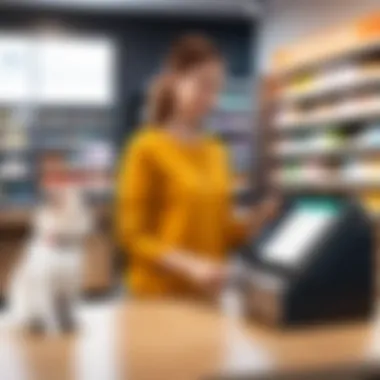Mastering Pet Shop POS Systems: A Comprehensive Guide


Intro
Pet shops today face numerous challenges in modern retailing. With the increased competition and ever-evolving consumer demands, the tools used to manage these businesses are more critical than ever. A robust Point of Sale (POS) system tailored for pet shops plays a vital role in addressing these needs. Understanding how to successfully implement and leverage a specialized POS system can significantly improve operational efficiency and customer satisfaction.
This discussion aims to shed light on the essential components of pet shop POS systems. We will explore important features, advantages, drawbacks, and strategic implementation options. The purpose here is not just to inform but to ultimately equip decision-makers and industry professionals with relevant insights to make informed choices in this rapidly changing marketplace.
Foreword to Pet Shop POS Systems
Pet shop POS systems are essential in the sphere of pet retail. They serve a vital function in helping shop owners manage both daily operations and customer interactions effectively. Understanding these systems is critical for industry professionals. This part of the article outlines the definition and various functionalities of such systems, along with their importance in enhancing the pet retail industry.
Definition and Functionality
A Pet Shop POS system, or Point of Sale system, is software that facilitates sales transactions. It helps in processing sales, tracking inventory, and managing customer data. At its core, it is designed to improve efficiency within a retail environment.
Key functionalities include:
- Sales Transactions: Accepting and processing payments through various methods.
- Inventory Tracking: Monitoring stock levels in real time, ensuring that products are available when customers want them.
- Customer Management: Organizing customer information and purchase history, which aids in tailored marketing efforts.
- Reporting Tools: Providing insights through sales reports, which can influence business decisions.
In addition, modern systems often integrate various software solutions, enhancing their functionality beyond basic sales processing.
Importance in the Pet Retail Industry
The significance of POS systems in the pet retail industry cannot be overstated. They provide essential support in both operational and strategic aspects.
Benefits include:
- Streamlined Operations: Automated processes eliminate manual errors and reduce time spent on tasks such as stock management and sales tracking.
- Enhanced Customer Experience: By efficiently handling transactions and providing personalized service through CRM capabilities, customers tend to have a better shopping experience.
- Informed Decision-Making: Accessible reporting and analytics allow businesses to evaluate performance and make data-driven decisions.
"Investing in a robust POS system can lead to substantial improvements in overall business performance."
Core Features of Pet Shop POS Systems
The core features of Pet Shop POS systems are integral to enhancing operational efficiency. These systems are designed to cater specifically to the needs of pet retailers, making them vastly different from conventional POS systems. Understanding these features allows industry professionals to optimize their business strategies, improve customer interactions, and manage inventory effectively. The significance of these features lies in their ability to create tailored solutions that address the unique challenges faced by pet shop owners.
Sales Processing and Transaction Management
Sales processing is at the heart of what a POS system offers. For pet shops, this feature goes beyond basic transaction handling. It supports various payment methods, including credit and debit cards, mobile payments, and gift cards, ensuring convenience for customers. This flexibility can lead to increased sales, as customers appreciate the choice. Transaction management also involves generating receipts and tracking sales trends, which provides valuable data for future strategic decisions. Additionally, integrations with loyalty programs can encourage repeat business, fostering a strong customer base.
Inventory Control and Management
Inventory control is critical for any retail business but especially so for pet shops. These shops often carry a diverse range of products, including pet food, toys, and grooming supplies. A robust POS system aids in tracking stock levels in real time. This ensures that popular items are always available while reducing excess stock on slow-moving items. Alerts for low inventory can help retailers order supplies timely, preventing stockouts that can lead to lost sales. Furthermore, advanced reporting features can analyze sales patterns, guiding inventory purchases and optimizing shelf space.
Customer Relationship Management (CRM)
A good Pet Shop POS system integrates Customer Relationship Management (CRM) functionalities. This aspect is vital for tailoring customer experience and building loyalty. Retailers can track customer purchases, preferences, and feedback. With this information, pet shops can personalize marketing efforts, such as tailored promotions on pet products that customers frequently buy. This personalized communication can enhance customer satisfaction and lead to increased sales. Moreover, nurturing customer relationships through targeted campaigns can separate successful retailers from their competition.
Reporting and Analytics Tools
Reporting and analytics tools are essential features that provide insights into business performance. Pet shop owners can access various reports covering sales data, popular products, and customer behavior. These insights assist in identifying trends and making data-driven decisions. For instance, if data indicates that a particular type of pet food sells well during summer, the business can strategize inventory purchases accordingly. The ability to analyze metrics such as sales per employee and average transaction value allows retailers to evaluate and optimize their operational processes effectively.
Comparing Pet Shop POS Systems with Conventional POS Systems
Pet shop POS systems are distinctively designed to address the nuances of pet retail. In this section, we will delve into the unique requirements faced by pet retailers and how these specifications set pet shop systems apart from conventional POS systems. Understanding these differences is crucial for industry professionals aiming to enhance operational efficiency through tailored solutions.


Unique Requirements of Pet Retailers
Pet retailers operate in a complex environment. They deal not only with a wide variety of products—ranging from food to grooming supplies—but also with an assortment of animal-related services. This diversity necessitates a specialized POS system that can accurately capture and manage inventory tailored to these unique needs. For instance, pet shop POS systems must handle specific product attributes such as:
- Expiration dates for perishable items like pet food.
- Custom product variants, including different sizes and flavors.
- Service bookings for grooming or veterinary visits.
Moreover, these systems should support pet-specific customer relationship management features, enabling retailers to manage customer profiles that include pet information, service history, and preferences. This level of detail significantly enhances customer loyalty and personalized service, attributes highly valued in the competitive pet industry.
Differences in Functionality and Features
When comparing pet shop POS systems with conventional systems, we see distinct differences in functionality and features aimed at addressing pet retail's specific needs. Conventional POS systems, while effective for standard retail operations, often lack the tailored functionalities required for the pet industry. Here are several key areas of distinction:
- Inventory Management: Pet shop systems include advanced inventory features like tracking of live animal sales and monitoring pet health records. Conventional systems typically do not account for such requirements.
- Sales Processing: Pet retailers often deal with varied unit types and pricing strategies, including bulk sales of pet food or multi-unit discounts for pet supplies. In contrast, many traditional POS setups may struggle with these unique pricing structures.
- Customer Engagement Tools: Features that enable direct communication with customers regarding their pets’ needs (such as reminders for vaccinations or grooming appointments) are vital in the pet retail space. Conventional systems often lack such targeted engagement functionalities.
"The ability to cater uniquely to pet owners is not merely an advantage; it’s a necessity for success in the pet retail sector."
Incorporating these tailored features not only improves operational effectiveness but also ensures an elevated customer experience, which is essential in today's market. Thus, understanding these distinctions helps pet retailers make informed decisions when selecting the right POS solution for their business.
Benefits of Implementing a Pet Shop POS System
Implementing a Pet Shop POS system is crucial for modern pet retail operations. These systems not only enhance customer experience but also streamline inventory management and overall efficiency. Pet retailers face unique challenges that require tailored solutions. A well-implemented POS system addresses these challenges directly, providing advantages that resonate across multiple facets of business operations.
Enhanced Customer Experience
A key benefit of utilizing a Pet Shop POS system is the potential for significantly improving the customer experience. Customers today expect fast and efficient service. A POS system can facilitate quicker transactions at the checkout by speeding up the sales processing. Customers appreciate being in and out of a store swiftly, especially if they are in a hurry. Additionally, integrated loyalty programs within the POS can reward repeat customers. This builds brand loyalty and encourages persistence in their shopping habits.
Beyond transactions, a good POS system can also maintain customer data effectively. This allows pet shops to personalize marketing campaigns based on purchase history. Knowing what types of pet supplies or services customers utilize can lead to tailored promotions that resonate more with them. Increased relevance in marketing approaches typically leads to higher conversion rates.
Improved Inventory Management
Inventory control is vital in the pet retail sector due to the variety of perishable items like pet food. A specialized Pet Shop POS system aids in tracking stock levels in real-time, allowing for proactive inventory management. With accurate data, business owners can avoid overstocking or understocking items, which can negatively impact cash flow.
Effective inventory management provides insights into which products are selling well, which ones are sitting on the shelf longer than expected, and allows retailers to plan accordingly. Automating reorders for popular products ensures that customers find what they are looking for, enhancing satisfaction and trust.
Documentation capabilities also extend to tracking suppliers, where their performance can be analyzed over time. This data can inform decisions on supplier selection and negotiation, ultimately contributing to better margins and product availability.
Streamlined Operations and Efficiency
Streamlining operations is another advantage of implementing a Pet Shop POS system. These systems often incorporate various functionalities from sales processing to inventory management into a single platform. By reducing the number of systems required for day-to-day operations, businesses minimize the time spent on repetitive administrative tasks.
For managers, generating accurate reports on sales and inventory levels can be done quickly and efficiently through the POS system. This allows for more informed decision-making, whether adjusting pricing strategies or determining when to introduce new products into the inventory.
Moreover, having a centralized data hub leads to fewer errors compared to manual entry systems. Inaccurate data can lead to poor decision-making and lost revenue, but a POS mitigates such risks significantly.
"Incorporating a well-rounded POS system into a pet shop can yield benefits that not only improve operations but also advance customer relationships."
Ultimately, the benefits provided by a specialized Pet Shop POS system cover multiple dimensions of business functioning, from enhancing customer experiences to improving back-end operations. For industry professionals seeking to elevate their retail practices, the adoption of these systems is not merely an option; it is increasingly a necessity.
Challenges in Adopting Pet Shop POS Systems
Adopting a Pet Shop POS system comes with its own set of challenges. Understanding these challenges is crucial for industry professionals aimimg to improve their operational efficiency and customer experience. Businesses must consider various factors, including costs, technical issues, and staff training needs. Addressing these aspects intelligently can help mitigate risks and ensure smoother implementation.
Cost Considerations
Cost is often one of the most significant considerations when implementing a new POS system. Pet shop owners should evaluate both initial expenses and ongoing operational costs. These can include:


- Software licensing fees: Many POS providers charge subscription fees that can vary widely.
- Hardware costs: Reliable equipment such as barcode scanners, cash registers, and receipt printers may add to the total investment.
- Maintenance fees: Some systems will require ongoing maintenance or support fees.
- Upgrades: As technology evolves, the need for upgrades can present additional costs.
Calculating the return on investment (ROI) is essential for making informed decisions. A detailed cost-benefit analysis can help pet shop owners understand the long-term value of the POS system in relation to its cost effectively.
Technical Issues and Integration Challenges
Technical problems are another important barrier. Integrating a new POS system with existing software can be complicated. Here are several points to consider:
- Data migration: Safely transitioning existing data to the new system is critical to avoid any disruptions in service.
- Compatibility: Ensuring that the new POS system is compatible with current software solutions can save time and resources in the long run.
- Downtime: System failures during installation can lead to significant operational delays.
- Customization: Businesses may require specific features that are not present in standard systems, complicating the integration process further.
Attention to detail in integrating systems can alleviate future headaches and maintain operational continuity.
Staff Training and Adaptation
Staff training is often underlooked but very important. When a new POS system is introduced, employees must adapt to the new technology. Here are some aspects of training to address:
- Comprehensive training sessions: Providing hands-on experience can boost employee confidence and proficiency with the new system.
- Ongoing support: Remember to offer assistance post-implementation to resolve any issues that might arise as staff start using the POS system in real-life scenarios.
- User feedback: Creating channels for staff to voice their concerns can help management refine the training process.
Failure to invest adequate time in training may lead to user errors, impacting overall efficiency and customer satisfaction. Involving staff early in the adoption process can also foster a sense of ownership and reduce resistance to change.
"Effective training is as vital as the technology itself; it defines how well a system will be utilized in day-to-day operations."
In summary, recognizing these challenges and approaching them thoughtfully can make the differences in successfully implementing Pet Shop POS systems.
Integration with Other Software Solutions
In today's competitive pet retail market, integrating a Pet Shop POS system with other software solutions is not just an added benefit; it is essential for streamlining operations and improving overall business efficiency. By connecting various system capabilities, pet shop owners can create a cohesive digital ecosystem that enhances data visibility, reduces manual entry errors, and ultimately delivers a better customer experience.
Accounting and Financial Software
Integrating a Pet Shop POS system with accounting and financial software such as QuickBooks or Xero allows for seamless financial management.
- Automatic Data Syncing: Transactions processed through the POS system update financial records in real-time. This minimizes discrepancies and saves significant time during the reconciliation process.
- Less Manual Input: Financial tasks require accurate recording. Automated integration cuts down on manual entry, reducing errors associated with human oversight.
- Improved Reporting: Integrated systems provide comprehensive financial reports. Business owners can keep track of revenue, expenses, and profit margins more efficiently, allowing for better budgeting and forecasting.
E-commerce Platforms
As more pet retailers expand online, integrating POS systems with e-commerce platforms like Shopify or WooCommerce is crucial.
- Unified Inventory Management: An integrated system ensures that inventory levels are updated across all sales channels. This prevents overselling and stockouts, which can adversely affect customer trust.
- Enhanced Customer Experience: Customers enjoy a smoother shopping experience when they can view real-time inventory status, purchase history, and personalized recommendations both online and in-store.
- Centralized Order Processing: Manually entering orders from e-commerce into a POS system is time-consuming. Integration simplifies order management, improving operational workflow.
Marketing Automation Tools
Marketing automation tools like Mailchimp or HubSpot can significantly enhance marketing efforts when integrated with a Pet Shop POS system.
- Targeted Campaigns: By leveraging customer purchase data from the POS, businesses can create specific marketing campaigns tailored to customer preferences, enhancing engagement.
- Customer Segmentation: Integrated systems allow for advanced customer segmentation based on buying behavior and histories, improving the effectiveness of promotional efforts.
- Automated Promotions: Integration can automate time-sensitive promotions, ensuring products are marketed effectively to the right audience at the right time, thus maximizing responsiveness.
Integrating a Pet Shop POS system with various software solutions can significantly impact operational efficiency and customer satisfaction. The necessity of achieving cohesion in software capabilities cannot be overstated, as it can lead to better decision-making and business growth.
Selecting the Right Pet Shop POS System
Choosing an effective Pet Shop POS system is critical for the success of any pet retail establishment. The right system can optimize operations, elevate customer experiences, and facilitate more precise inventory management. It serves as a backbone to the business, influencing efficiency and profitability.
This section discusses vital elements to consider in selecting the appropriate POS software. It will cover how to assess business needs, evaluate available software options, and understand cost-benefit aspects.
Assessing Business Needs


Before diving into software options, it is essential to deeply understand your specific business needs. Each pet shop is unique, with different types of products, services, and customer expectations. You should start by analyzing the following areas:
- Product Range: Consider the variety of pet products you offer, like food, toys, or grooming supplies. Each category may necessitate different features.
- Customer Demographics: Identify your typical customers. Understanding their preferences can inform your choices, such as if mobile payment options are important.
- Operational Scale: Evaluate the size and scope of your operation. A small store may not require as many advanced features as a larger establishment.
- Future Growth: Look at your long-term business goals. Choose a system flexible enough to evolve with your needs.
By methodically assessing these factors, you can create a clear picture of your essential requirements, making the selection process more focused and strategic.
Evaluating Software Options
Once business needs are defined, the next step is to evaluate the myriad of software options available. Here’s how to approach this process:
- Feature Comparison: Document the features that are vital to your operations. Important functionalities may include inventory tracking, sales reporting, customer management, and integration capabilities with other tools, like e-commerce platforms.
- User Experience: Consider the interface of the software. It should be user-friendly, as staff will need to navigate it easily during busy hours.
- Scalability: Ensure the POS system can grow with your business. Features like cloud capabilities allow for seamless updates and scalability.
- Vendor Reputation: Research vendors by reading reviews and asking other business owners for their recommendations. Reliable support and service are crucial for any software adoption.
Evaluating these aspects thoroughly will help in pinpointing a POS solution that aligns with your requirements.
Cost-Benefit Analysis
Understanding the financial implications of adopting a new POS system is essential. A Cost-Benefit analysis should weigh the initial outlay against the expected benefits. Here are some points to consider:
- Initial Costs: Include purchase prices, installation fees, and training expenses.
- Ongoing Costs: Account for subscription fees, maintenance, and updates. Some systems charge monthly fees based on usage.
- Savings and Revenue: Assess how the system could enhance efficiency and potentially increase sales through better customer engagement.
- Intangible Benefits: Additionally, consider benefits that are less direct but valuable, such as improved customer satisfaction and staff morale. A well-functioning POS can reduce frustrations and mistakes.
When all these elements are evaluated, a clearer picture on the financial return on investment will emerge. This analysis assists in making an informed decision on selecting the right Pet Shop POS system for your business.
"Selecting the ideal POS system is not just a tech upgrade; it's a strategic investment in operational success."
Future Trends in Pet Shop POS Technology
Future trends in Pet Shop POS technology are crucial for the evolving landscape of the pet retail sector. Understanding these trends allows businesses to prepare for upcoming changes and adopt technologies that can lead to enhanced operations and customer experiences. Businesses can gain a competitive edge by integrating advanced technologies into their framework. The following sections will explore how advancements in artificial intelligence and mobile and cloud-based solutions can transform POS systems in pet shops.
Advancements in Artificial Intelligence
Artificial intelligence (AI) is increasingly influencing pet shop POS systems. AI-driven insights can assist retailers in making data-driven decisions regarding inventory and customer preferences. For instance, by analyzing sales data, AI can forecast trends and suggest optimal stock levels. This capability reduces overstock or stockout situations, which enhances customer satisfaction.
Another area where AI shines is in customer relationship management. AI can analyze customer interactions and purchase history, allowing retailers to personalize marketing efforts. For example, automated customer service solutions powered by AI chatbots can provide support round the clock. This increases engagement and improves customer experience by offering quick responses to inquiries.
"Adopting AI in POS systems helps pet retailers anticipate customer needs effectively, enhancing overall operational efficiency."
Mobile and Cloud-Based Solutions
Mobile and cloud-based solutions are rapidly becoming essential components of modern pet shop POS systems. These technologies offer flexibility and accessibility, allowing retailers to manage operations from anywhere. With mobile POS systems, staff can check out customers and manage various processes outside the traditional checkout counter. This not only streamlines operations but also enriches the in-store experience.
Cloud technology plays a significant role in improving the functionality of POS systems. Storing data in the cloud allows real-time updates and access to information across multiple locations. Retailers can benefit from better inventory management and sales tracking without the need for extensive hardware installations. This leads to lower operational costs and greater scalability for businesses.
Finale
In this article, we have explored the intricacies of pet shop POS systems, underlining their significance for modern retail management in the pet industry. As businesses evolve, so does the need for effective technology solutions. The ability to manage sales, inventory, and customer relations seamlessly is not just a luxury but a necessity.
Recap of Key Insights
The discussion centered on several critical aspects of pet shop POS systems. We highlighted the core features such as sales processing, inventory management, and customer relationship management. Each of these components plays a vital role in enhancing operational efficiency. Some key points include:
- Sales Processing: Ensures quick and accurate transactions, increasing customer satisfaction.
- Inventory Control: Helps in minimizing stock discrepancies and optimizing stock levels.
- CRM: Fosters stronger customer loyalty and personalized experiences.
- Reporting Tools: Provide vital data that guide strategic decision-making.
"In an industry where every sale can impact customer loyalty, an efficient POS system is non-negotiable."
These insights contribute to a more focused understanding of the benefits involved in adopting an appropriate POS system tailored to the unique specifications of pet retail.
Final Thoughts on Implementation
Choosing to implement a pet shop POS system requires careful consideration of various factors. The benefits seen in improved customer experience and streamlined operations are significant, but they come with certain challenges. It's crucial to weigh the cost against potential efficiency gains while also addressing factors like staff training and system integration. A thoughtful approach to these elements can lead to successful implementation.
Implementation should also consider the evolving nature of technology in retail. Staying abreast of trends, such as advancements in artificial intelligence and mobile solutions, can ensure that the chosen system adapts to future needs. Such foresight helps maintain competitiveness in a rapidly changing environment.







